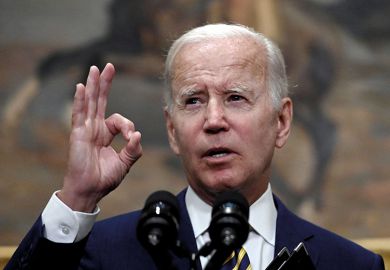Last month, I wrote two cheques. The first paid off my son’s first week at day care. The second covered his first semester of college. My wife and I could have waited until next month for the federal government to write off the debt. But people like us shouldn’t receive such breaks.
I am an academic physician at the nexus of America’s debt crisis. Consulting a physician has 23 million Americans carrying billions of dollars in debt, and this debt is concentrated among the most vulnerable in society: the uninsured, the undocumented, the unemployed.
Educational debt, by contrast, is more dispersed. At the safety net hospital where I work, I am responsible for bringing in more than 2,000 students in 38 different health professions and at least 1,000 resident physicians annually. Some have no debt, others owe hundreds of thousands of dollars. In recent weeks, I have heard many of them talking about loan forgiveness. They all favour forgiveness but disagree over the correct amount. I disagree about the recipients.
The Biden administration has announced that it will forgive up to $20,000 (£17,500) for Pell Grant recipients and $10,000 for others, provided their annual income is less than $125,000 for individuals or $250,000 for married couples, regardless of their profession. Debt can cripple a person’s future, so I am grateful that significant debts are being forgiven. I just wish the government wouldn’t forgive doctors – at least, not all of us.
It’s a different thing to forgive the debts of nurses than of neurosurgeons. My wife and I are both physicians. Ours was a med school romance. We exchanged our I dos on a weekend between our psychiatry and anaesthesiology clerkships. When we told the dean of student affairs that, a scant 10 months after the wedding, we were beginning a family, she laughed at our lack of timing.
Medical school deans typically counsel deferring having children until after training, but ours quickly pivoted from laughter to support, arranging for us to increase our federal student loans so we could afford to care for our infant son, Eamon. Our student loans are therefore a consolidated combination of tuition from our colleges, medical school and our son’s day care. Eighteen years later, I finally paid off Eamon’s childcare on the day he went off to college.
In a way, the loans subsidised the childhoods of Eamon’s two younger sisters as well. The federal government offered us a 30-year consolidated loan at modest interest rates. When we bought a home, it offered us another agreeable rate. Along the way, a year in AmeriCorps earned me $5,000 of debt forgiveness. And after several years working in a public clinic, our state forgave $45,000 of my wife’s med school loans.
Best. Deal. Ever.
These loans enabled our demanding but rewarding life as physician-parents. The principal rewards are the privilege to care for the ill, to teach the next generation and to study how to do both better. But the financial rewards, even in one of medicine’s less remunerative fields, are profound.
Consider the two professions, teaching and medicine, that Eamon is currently considering. The living standards of psychiatrists like me have moved upstream economically along with those of other professionals. When I was born in the 1970s, the median starting salary of a psychiatrist in academic medicine was $17,000 – not much more than the $15,970 median salary an American public school teacher earned. And even by the late 1990s, the two salaries were still comparable: $69,000, versus $59,924.
However, by the time today’s medical students entered medical school, the median starting salary for an academic psychiatrist was $182,000, a whole different zip code from the teacher’s declining median salary of $58,950. And if that psychiatrist becomes chair of her department, her median salary of $448,000 will put her in a separate country entirely from the one that school teachers inhabit.
Becoming a physician is a life of service. In pursuit of it, many medical students graduate with significant debt, which worsens burnout and discourages public service. The most recent class of medical school graduates owe a median of $200,000. The problem of physician debt is real. But it ought not be society’s priority. To address physician debt, we can redistribute the billions of dollars we already invest in physician education. In 2020 alone, federal and state subsidies for graduate medical education in the US exceeded $18.7 billion.
Debt forgiveness should be targeted at people committed to the essential industries, which were so severely strained by the pandemic. We need daycare workers, skilled tradespeople and nurses. We need teachers. We need physicians, too, but last year was a record year for medical school applications.
If we are going to forgive educational debt, we ought to forgive the debts of the people entering the professions where essential jobs go wanting. In medicine, that would mean primary care physicians. In society, that would mean capping debt forgiveness by income and profession.
Abraham M. Nussbaum is chief education officer for Denver Health and professor of psychiatry at the University of Colorado School of Medicine.
POSTSCRIPT:
Print headline: I’m a doctor in the US and I don’t want my student debt forgiven
Register to continue
Why register?
- Registration is free and only takes a moment
- Once registered, you can read 3 articles a month
- Sign up for our newsletter
Subscribe
Or subscribe for unlimited access to:
- Unlimited access to news, views, insights & reviews
- Digital editions
- Digital access to THE’s university and college rankings analysis
Already registered or a current subscriber?








